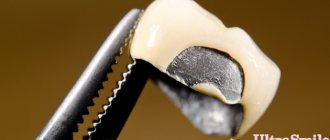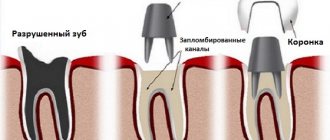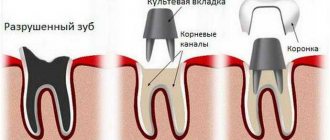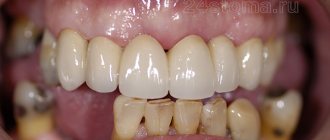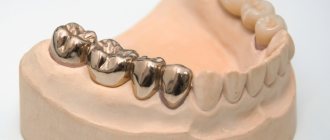Metal-plastic crowns
Such prostheses are called conditionally temporary crowns. A cost-effective prosthetics option that involves installing crowns with a metal base and a plastic coating. Traditionally, structures are made of nickel, cobalt, and chromium.
Despite the natural appearance and relatively good functionality, it is not worth wearing such prostheses for a long time: the product quickly loses its whiteness, slightly increases in size and needs to be replaced.
Among the undeniable advantages of metal plastic are its low cost and gentle effect on the enamel layer of the tooth. If the product is slightly deformed, it can be repaired directly in the patient’s mouth. Among the disadvantages of this choice, it is worth highlighting the low strength of the structure and the likelihood of developing allergies.
Indications for installation
Artificial crowns are installed in place of the destroyed part of the tooth. The procedure is carried out according to indications:
- more than 70% of the natural tooth crown is destroyed;
- inability to use other correction methods;
- there are large cracks and chips on the enamel;
- a fracture of the natural crown was established;
- high abrasion of enamel in the patient.
Temporary crowns are installed while the tooth is being treated. They allow you to maintain an aesthetic appearance and a beautiful smile.
Metal-ceramic crowns
Practice shows that metal-ceramic crowns are deservedly considered the most popular. The base of the product is metal (cobalt, chromium, titanium, gold, etc.). To give the crown an aesthetic appearance, the metal base is covered with a ceramic layer and the elements are connected by exposure to high temperatures.
The popularity of metal ceramics in prosthetics is explained by its obvious advantages:
- Aesthetics. The material with which the crown frame is covered completely recreates the anatomical structure of the enamel;
- Sufficient strength. The products are quite durable due to the cast metal frame - they can withstand normal chewing loads and do not wear out. It is rare to see chipping of the enamel coating. In this case, repair of the prosthesis can be done in the patient’s mouth;
- Versatility. Crowns of this type are installed both on individual fragments of a row, and in the form of a dental bridge.
Since the ceramic layer is completely opaque, the prosthetic fragment (especially with a single restoration) can stand out against the background of natural teeth. Another disadvantage of metal-ceramic crowns is the need to grind the unit, after which it forever loses its original shape.
Metal crowns
These are the predecessors of all other types of dentures. This type of prosthesis is indicated for installation only on chewing teeth, since the structures are noticeable on the front teeth. Metal crowns are made of steel, titanium, platinum, and gold. Alloys containing cobalt, chromium, and silver are also in demand.
In laboratory conditions, stamped or cast products with spraying are prepared for patients. Standard structures take on the desired shape as work progresses. Individual production of the cap guarantees maximum adherence to the tissues, which eliminates rapid abrasion of the material and the spread of bacteria under the prosthesis.
Among the advantages of such products, it is worth noting their exceptional strength (due to the plasticity of the material, a crown made of this type of material does not crack and does not wear out for a long time). However, metal dentures are extremely unaesthetic, can cause allergies, and are difficult to fit on a tooth.
In addition, when using metal prosthetics, it is worth considering that crowns made from several types of metal cannot be used at once. If the patient already has a steel structure in his mouth, in the future he will have to fix crowns only from this material. Otherwise, the patient may develop galvanic syndrome, which is manifested by a burning sensation in the mouth and a “metallic” taste.
Why do we need to change?
There are a number of reasons for this:
- Over time, the product loses its color and shape, especially when a low-quality prosthesis is installed or when the technological process of prosthetics is violated. The materials from which they are made absorb coloring substances contained in food and drinks. This causes darkening and highlighting of the dentition;
- individual intolerance to the composition from which the crown/bridge is made;
- inflammation of the gums, constant feeling of discomfort. The condition of the tissue around the supporting tooth directly affects the durability of the structure itself, which often leads to its loosening. Symptoms such as the appearance of blood during cleaning, swelling and redness should not be ignored. It is important to immediately make an appointment with a doctor and begin treatment;
- the support that is necessary for installing the orthopedic product is destroyed. As a rule, this is associated with the manifestation of caries, due to which the remaining part of the tooth dies over time, and the strength of the fixation is impaired;
- Some people experience changes in bone tissue, which leads to visible changes in the proportionality and structure of the jaw. This is because bridges cannot stop bone atrophy, in which the gums and jaw become smaller over time. And if the orthopedic design no longer matches the gums and jaw, then its stability is lost and the need for correction or replacement arises.
Ceramic crowns for teeth
Metal-free crowns are deservedly recognized as the most aesthetic: they are extremely difficult to distinguish from natural teeth, even if the gum tissue becomes thinner, the prosthesis remains invisible and looks natural. In dentistry, several types of metal-free dental crowns are used:
- Porcelain or all-ceramic. They are made according to a personal impression from pressed material without adding other components.
- Mixed (zirconium dioxide and ceramics). They are stronger than the previous type of prosthesis, have high light transmittance and do not cause allergies.
- Mixed (aluminum oxide and ceramics). The designs are made of translucent hypoallergenic material, which is comfortable to wear and resistant to temperature changes.
All ceramic products are biologically compatible with mucous membranes and do not tend to cause allergic reactions. Other advantages of the designs include:
- light weight (a crown can be installed even on weakened teeth);
- immunity of ceramics to dyes;
- the need for minimal tooth grinding before ceramic prosthetics.
The disadvantages of this method of prosthetics include the relatively high cost of the products, as well as their fragility. Ceramic structures are not designed for significant chewing loads, which is why they are more often used for prosthetics of the upper incisors.
If you properly care for ceramic products, they will last from 10 to 15 years. At the same time, the prosthetic structure is not susceptible to caries and does not accumulate plaque.
How is a crown installed?
When the choice of prosthesis is made, all that remains is to install it. Many people worry and reluctantly go to the dentist, not knowing what awaits them. To have at least some idea about a visit to the dentist, you should understand how he will install the crown.
- The installation procedure is not as fast as we would like, and definitely takes more than one day.
- First of all, you need to visit a dentist so that he can determine the extent of damage to the tooth, and whether you need a crown or not.
- After the examination, you will be sent for an X-ray to identify any defects.
- Next comes the preparatory stage for installation. If necessary, the doctor treats caries and other dental diseases. If the tooth has been completely destroyed, a permanent pin is installed in the root.
- As we already know, the crown is delivered on the filed edges of the tooth, so the next step will be grinding. This is necessary to ensure that the crown sits firmly and does not create backlash.
- After grinding, the process of making a cast of the future prosthesis begins.
- Melting the crown itself includes choosing the shade of the future “replacement” tooth.
- As soon as the crown is ready, you need to try it on to make sure that it fits you exactly and will not interfere, press or cut your gums. The denture is installed for a certain period of time.
- If temporary wear does not cause any discomfort, then the dentist fixes the prosthesis permanently using medical cement.
Zirconium dioxide crowns
Zirconium crowns are prepared in laboratory conditions using high-precision computer equipment. Laser scanning allows for an accurate analysis of the dentition, after which a computer program models an accurate crown for the tooth. Optical data is transferred from the computer to a milling machine, which grinds the prosthesis from the workpiece.
These types of dental crowns are the most expensive. Their price is justified by a number of obvious advantages:
- Strength. Zirconium dioxide is as durable as natural tooth enamel. Even solid bridges can be made on the basis of this material;
- High aesthetics. The shade of zirconium dioxide can easily be matched to the color of the natural enamel layer;
- Biological compatibility. Zirconium dioxide is safe for human health. This type of prosthetics is not contraindicated for patients with metal allergies.
The products are recommended for installation by patients who have high demands on the appearance of structures and want their new teeth to be indistinguishable from natural elements.
Making a prosthesis in a dental laboratory - the fourth stage of crown installation
We have already told you about the technologies for making dental crowns above. Dental crowns are made from a dental impression: first, the crown is modeled, and then a finished prosthesis is produced, which will be tried on by the patient.
Of course, the most modern technologies are now used in the production of crowns, but the quality of the prosthesis will still depend 90% on the professionalism of the dental technician, which again suggests that dentistry for prosthetics and installation of crowns must be chosen thoughtfully. Find out all possible information on the clinic’s equipment, the level of training of its specialists, and its reputation among patients. Beautiful advertising is attractive, but it does not guarantee high quality treatment!
Our dentistry in St. Petersburg - "NewLineDent" enjoys an impeccable reputation among its patients, because we do not promise the lowest prices, do not write catchy and flashy slogans - we simply do our work conscientiously, at a professional level! Most patients come to us not because of advertisements, but because of recommendations from friends, acquaintances, and relatives, and we are proud of this! If we are recommended, they trust us, and the trust of patients is a reason for pride! Come to us too - for quality treatment, healthy teeth, and a beautiful smile!
Gold crowns on teeth
Separately, it is worth noting the type of metal crowns - gold products. In dentistry, pure material is not used in the manufacture of dentures, since gold is a soft metal. Traditionally, an alloy with palladium and platinum is used. The structures fit well, do not irritate the mucous membrane, and do not lead to bleeding gums.
Very often, gold dentures are coated with a ceramic layer. Such products can even be placed on the front teeth: they retain the beneficial properties of the base material and look good.
When does pulp need to be removed?
Depulpation is not a mandatory procedure before prosthetics, but it cannot be avoided if there are the following indications.
- Advanced caries or caries at the very root of the tooth.
- Pulpitis or periodontitis.
- Partial exposure of nerves during grinding of enamel.
- Anatomically incorrect position of the tooth.
- Tooth injury, which may result in partial death of the nerves.
- Hypersensitivity.
- Low landing crown.
If there is a need to remove the nerve after the crown has been installed on a living tooth, then depulpation can be carried out without removing the crown. The doctor makes a hole, removes the nerve, and then fills the hole with polymer. After such a procedure, the prosthesis does not lose its performance properties.
Temporary crowns on teeth
Since dental prosthetics requires time, the patient is often given temporary crowns. The patient wears the dentures until the permanent dentures are ready.
We are talking about inexpensive polymer, acrylic, and plastic crowns, which are designed to protect the prepared units from displacement and pathogens. In addition, they perfectly perform an aesthetic function, masking “holes” in the oral cavity.
Temporary crowns can be placed on natural teeth or on implants. Due to these structures, an even distribution of the chewing load is ensured, the risk of jawbone resorption is reduced, and the rate of adaptation to a permanent prosthesis is accelerated.
Ranking of dental crowns by nomination
| The most | |
| Aesthetic | Unaesthetic |
| Zirconium | Metal |
| Durable | Short-lived |
| Zirconium/Metal | Metal-plastic |
| Biologically compatible | Unsafe for the body |
| Zirconium/Ceramic/Metal-ceramic with gold-platinum alloy frame | Nickel-based metal-ceramic |
What dentures are best for the front teeth?
Since the teeth in the smile area are visible to others, high aesthetic demands are placed on prosthetics in this area. In this regard, it is better to install prostheses made of zirconium dioxide (aluminum oxide), metal ceramics or all-ceramic crowns on the front teeth.
Caps made of solid ceramics are put on the upper incisors; they look good and are not subject to heavy loads. Products are made from medical porcelain using injection molding.
The lower incisors and canines bear a significant load, so in this case, solid ceramics are replaced with zirconium dioxide. The durable frame is coated with a ceramic layer to create a reliable and attractive prosthesis for the front teeth.
In addition, zirconium dioxide is successfully used when installing dental bridges in the smile area.
What is better to put on chewing teeth?
Since the chewing teeth bear the bulk of the load, the crowns on them must be strong. Most often, metal-ceramic crowns are placed in the lateral sections. Metal ceramics are durable and aesthetic, but require significant grinding of dental tissue.
Zirconium dioxide has proven itself to be excellent. Its strength is comparable to the strength of metal crowns; only zirconium prostheses, unlike metal ones, are very similar to natural teeth. Another advantage of this choice is the insignificant grinding of tooth enamel before prosthetics.
All-metal crowns on teeth are cheaper. They have a long service life and are resistant to corrosion. An even more significant disadvantage of such prostheses (in addition to the low level of aesthetics) is the risk of developing an allergy to the material.
Crown installation is the final stage of prosthetics
Before installing a crown on a tooth, you will need to try it on. The fitting consists of the doctor placing a crown on the tooth stump and securing it with temporary cement. You will have to walk around with a temporary crown for some time: this is necessary to evaluate the quality of the prosthesis and the comfort of its use. If during the fitting no defects are found in the crown, the doctor will fix it on the tooth with the help of permanent cement.
If the tooth on which the crown will be placed has not been depulped during the preparation process, anesthesia is first administered. Putting a crown on a tooth does not hurt, but some discomfort may occur because the tooth enamel has been previously ground down. The finished crown is firmly fixed to the tooth using special dental cement, and at this point the installation process can be considered complete.
Duration of operation of different types of crowns
The most short-lived structures are made of metal-plastic. Therefore, they are traditionally used as temporary crowns. The maximum service life of products is 5 years. According to patient reviews, over time the plastic coating deforms and darkens.
Metal-ceramics is a practical option that is installed on both the front and chewing teeth. Such structures last up to 10 years.
Crowns made of medical porcelain do not darken or fade and can last up to 10-15 years. Throughout this period, the product looks like a natural tooth.
Crowns made of zirconium dioxide are considered even more stable: their service life is 15-20 years.
Prostheses made from precious metal alloys and products made from nickel are also durable and can last up to 15 years.
The service life of different types of crowns depends not only on the material, but also on the accuracy of installation. There should be no voids or gaps under a well-fixed crown. Otherwise, food debris will accumulate under the product, which over time will lead to the development of an inflammatory prosthesis.
Which crown is better: rating
Below we will talk about the best options for prosthetics of chewing teeth in different clinical situations. In Table 1 you can see which crown is better in situations where only single crowns are needed, or when we are talking about restoring a missing tooth with a bridge. The types of crowns in the table are listed from best to worst.
Dental crowns: which ones are best for chewing teeth (Table 1) –
| Single crown | Bridge prosthesis | |
| 1. | pressed ceramic E.max | made of zirconium dioxide |
| 2. | made of zirconium dioxide | combined bridge * |
| 3. | metal ceramics | metal ceramics |
| 4. | solid crown | solid bridge |
* This prosthetic option involves a combination of metal-ceramic and solid-cast bridge prosthesis. So, if from the table it has already become clear to you which crown is best to place on chewing teeth, then below you will find a detailed description of the pros and cons of the above types of crowns in various clinical situations.
1) Crowns/bridges made of zirconium dioxide –
Zirconium dioxide is a metal-free ceramic. This type of ceramic has very high strength (more than 900 MPa), which is comparable to the strength of metal, as well as a higher level of aesthetics - compared to metal ceramics. If you need to make a bridge on the chewing group of teeth, then a zirconium dioxide bridge will be the best option. But if you need to make a single crown, then zirconium is inferior to pressed glass ceramics E.max.
Pressed glass ceramics E.max has: 1) better aesthetics, 2) it has a lower risk of chipping the ceramic mass, but it cannot be used to make bridge-like prostheses resting on the distal chewing teeth. Therefore, if at least one of 6-7-8 teeth must act as supports for a bridge, the only ceramic option will be zirconium dioxide. If you need a single crown, read the next section about E.max ceramics.
Important: Most often, zirconium dioxide crowns/bridges consist of two layers. First, the zirconium frame of the future crown/bridge is milled on a computer-controlled machine (similar to the metal frame of metal-ceramics). After firing in the kiln, layers of porcelain in different shades are applied to this frame to match the color of the adjacent teeth.
The second manufacturing option is that crowns/bridges are made from monolithic zirconium dioxide (without subsequent application of porcelain layers). This option has a big advantage - there is absolutely no risk of ceramic chipping, but the aesthetics will be worse. According to statistics, when making zirconium crowns with surface application of porcelain, ceramic chips occur in approximately 10% of patients after 6 years of using such crowns.
At the same time, studies show that the risk of ceramic chips in metal-ceramic crowns is approximately 2 times lower (than in zirconium crowns with a surface layer of porcelain). And the risk of chipping with pressed E.max glass ceramics will be even lower. Therefore, to the question: which crowns are best placed on chewing teeth, the answer is that bridges are best made from monolithic zirconium dioxide, and single crowns from E.max.
→ Cost of zirconium dioxide crowns/bridges
2) Crowns made of pressed ceramics E.max –
Two single crowns from E.max – before and after photos
E.max glass ceramics are the best option for metal-free ceramics if you have the highest demands on the aesthetics of your crowns. This type of ceramic has a high strength of 400 MPa (which is less than that of zirconium dioxide), but this is more than enough for prosthetics of posterior teeth with single crowns. But for the manufacture of bridges supported by 6-7-8 chewing teeth, this strength will no longer be enough, and therefore bridges from E.max are made more often for the front teeth.
E.max comes in two main types. Firstly, this is the “E.max PRESS” material, intended for the manufacture of crowns/bridges using the pressing method at high temperature and pressure. Let's say right away that this material is much better and somewhat cheaper than the second one. Secondly, the “E.max CAD” material, which is intended for the manufacture of crowns using the milling method (CAD/CAM technology, which is also used for the manufacture of zirconium crowns).
Important: E.max crowns/bridges can be (as well as zirconium) made either monolithic or consist of 2 layers - a pressed frame on which porcelain mass will be applied. Monolithic structures have the lowest risk of ceramic chipping, while layered structures have the best aesthetics. Not long ago, a new material “E.max PRESS Multi” appeared, which makes it possible to make very aesthetic monolithic structures, from which we recommend making all single crowns for chewing teeth.
→ Cost of crowns/bridges from E.max
3) Metal-ceramic crowns/bridges –
A more budget-friendly option is metal-ceramic prosthetics. Its main aesthetic disadvantages are more modest aesthetics (compared to metal-free ceramics), the development of cyanosis of the gums around the crown, and also, over time, gum recession with exposure of the metal edge of the crown. But on the other hand, chewing teeth are not visible when you smile, which, given a limited budget, makes metal-ceramics a good choice.
Below we have posted examples of prosthetics for missing chewing teeth using metal-ceramic bridges (before and after photos).
But aesthetics should not be the only selection criterion. The fact is that for metal-ceramics, teeth are ground on different sides by 2.0-2.5 mm, and for metal-free ceramics - only 1-1.5 mm. Thus, ceramic prosthetics allows you to preserve more hard tooth tissue under the crown, which increases its service life. The cost of one metal-ceramic crown starts from 8,000 rubles (for the most budget-friendly manufacturing option, using the cheapest materials made in Russia and Belarus).
On average, for a budget option using imported economy-class materials (for example, Duceram ceramic mass, Germany) - it costs from 10,000 to 12,000 rubles for 1 crown. If the issue of aesthetics is important to you, then the production of metal-ceramics using high-quality and expensive ceramic masses Vita (Germany), Noritake (Japan), Ivoclar (Liechtenstein) will cost at least 15,000 rubles for 1 crown. It is also worth considering that the indicated price does not take into account some additional costs.
→ Calculation of the cost of metal ceramics
4) Solid crowns/bridges –
Crown bridges on the back teeth (which do not fall into the smile line) do not have to be white and beautiful. There are metal cast crowns that are made of chromium-cobalt alloy. Such crowns have the color of polished metal, or by spraying they can be given a “gold” color. They have a long service life, and besides, the teeth under them are ground to a lesser extent than under metal-ceramics.
→ Calculation of the cost of cast crowns
5) Combined bridges –
If you need to make a bridge of 3 crowns on the chewing teeth (for example, supported by the 5th and 7th teeth), the design can be made in an unconventional way... The first 1-2 crowns that fall into the smile line can be made metal-ceramic, and the distant ones 1-2 crowns can be made solid and look like polished metal. This will be somewhat cheaper, and besides, it turns out that the abutment tooth for a cast crown will be ground down to a lesser extent.
How to properly care for crowns
The method of caring for crowns is practically no different from the principles of caring for natural teeth and involves:
- performing oral hygiene twice a day (not only the teeth, but also the tongue should be brushed);
- cleaning the spaces between teeth and the space under dentures. To ensure the proper level of hygiene, it is preferable to use an irrigator: a directed jet helps to quickly and painlessly clean the space under the product;
- nutrition correction - excluding too hard foods and temperature changes from the menu;
- monitoring the condition of the gums and areas where teeth meet crowns (this is where caries most often develops);
- using mouth rinses after each meal (special formulations can be replaced with plain water).
Dentists also advise periodically massaging the gums under the structure. Soft tissues undergo increased pressure, so it is important to stimulate blood circulation in these areas. The gums should be massaged with smooth circular movements clockwise and counterclockwise.
How much does it cost to install a crown on a tooth?
The key criterion that determines the cost of prosthetics is the material used to make the prosthesis. If you arrange them from cheapest to most expensive, the list will look like this:
- metal-plastic;
- metal;
- gold;
- metal ceramics with ordinary metals;
- metal ceramics on a gold base;
- ceramics;
- zirconium dioxide.
In addition to the material, the price of the prosthesis is also influenced by the pricing policy of the clinic, the equipment used, and the qualifications of the attending physician. Some clinics manage to save money on prosthetics by installing crowns on several teeth at once.
It is impossible to accurately answer the question of which crown is best to install. The doctor makes the decision together with the patient. When choosing, emphasis is placed on clinical indications, characteristics of the patient’s jaw system, the state of oral health in general, the wishes and financial capabilities of the person.
Installation process
The procedure for installing a crown is multi-stage. Often the patient has to visit the doctor more than two or three times. It all depends on the initial condition of the teeth and their sensitivity to the therapy, if necessary.
At the initial stage, the doctor conducts a diagnosis, determines the plan and scope of work, and calculates the approximate cost. Often at this time it is still unclear how long the treatment will take, because each body reacts to therapy in its own way.
Laboratory stage
Most of the steps involved in installing a crown take place in the laboratory. At this stage:
- obtain dismountable models of jaws from plaster;
- make a stamped crown;
- grind and polish the product to an ideal shape.
The laboratory accompanies the patient at all stages of installation. The crown can be returned for revision even at the very last moment, since it is important that the patient feels comfortable wearing it.
Grinding the tooth before installation
The most difficult stage, which most patients fear, is teeth grinding. It is necessary to ensure that the crown fits perfectly to the gums. If this is not observed, a pathological pocket will form. Food will get stuck in it, which will cause inflammation and can lead to tooth extraction.
Grinding is carried out under anesthesia, so the patient will not feel anything. Only the top layer of enamel is ground. The tooth itself is not damaged; only 1-2 mm are removed. The depth of work depends on the selected crown material: a smaller volume is sufficient for ceramics, while metal-ceramics require more space.
The purpose of grinding is to equalize the width of the tooth at the neck and at the equator. This is necessary for strong fixation of the crown. It is covered by the gums, which prevents loosening. After processing, there should be no convex parts left - they are sanded off with a special apparatus. At the same time, the chewing teeth must maintain their relief in order to fully perform their functions.
In some cases, during turning, depulpation is additionally performed. This is done according to strict indications, about which the patient is warned in advance.
In case of extensive tooth decay, a stump inlay can be installed. It protects healthy soft tissues from the pressure of the crown on them. Previously, in this case, installation was carried out using pins. Now this technique is not so relevant, since the operation is associated with certain risks. And if it is possible to avoid them using a stump tab, it is better to do so.
Installing a crown on a tooth
A permanent crown is not installed immediately. First, a fitting is carried out, during which the patient evaluates several parameters:
- shape;
- wearing comfort;
- color.
If one of the parameters does not fit, it is better to redo the crown. After all, you need to remember that it will take a long time to wear it, and the cost of manufacturing and installation is usually expensive.
And the appropriate crown is securely fixed with cement. The strength of the installation is checked by a doctor to ensure that the prosthesis does not accidentally fall out.
Monitoring the situation after installation
Once the crown is in place, you need to check whether the installation was completed correctly. To do this, a panoramic or targeted photograph of the oral cavity is performed, depending on the number of installed dentures. Only after this the doctor allows the patient to go home.
If a patient has questions about discomfort or inconvenience when wearing a crown, he can call the doctor at the OWN PEOPLE clinic and ask all his questions. Our dentists care about their clients and are always responsible for the results of the procedure.
Alternatives to a Dental Crown
Veneers are often preferred to crowns in the smile area. However, in this case, the back side of the elements should be more or less preserved.
Teeth can be restored using filling materials. This method can only be used if the destruction of the unit is not so global (less than half).
Judging by the reviews of doctors and patients, crowns are considered the optimal solution for significant damage to teeth, since they not only restore the functionality and aesthetics of a row, but also protect teeth from further destruction. An additional bonus of this type of prosthetics is the variability of materials and, accordingly, the cost of services.




